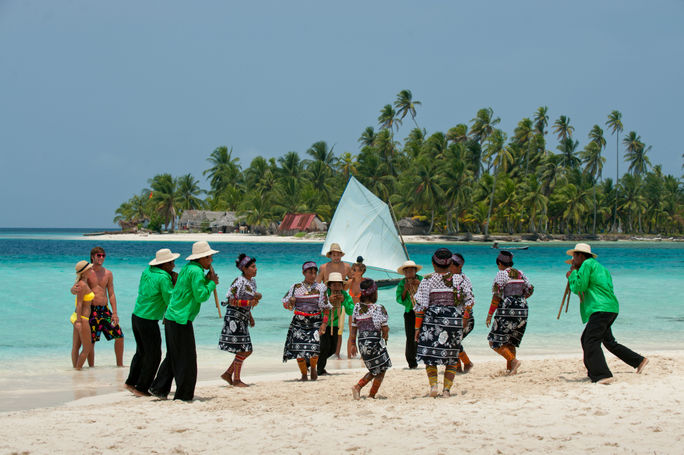Panamá has been a meeting place for goods, peoples and ideas from around the world for centuries. While it’s most known for its canal, a feat of human engineering that connects the Pacific Ocean to the Atlantic, it’s also home to seven distinct indigenous communities, as well as African and Spanish cultures and heritages.
Travelers can look to two of Panamá’s indigenous cultures for a glimpse into traditional cultural practices that have survived and evolved over thousands of years, including in the important tradition of dance.
The Guna are a coastal community living primarily in the San Blas Islands, which makes a visit there a great opportunity for day trips. While there, travelers can enjoy traditional Guna cooking, which makes use of plentiful coconuts and seafood, learn how the traditional woman’s dress, the colorful and intricately designed mola, is made, and even sleep over in a thatched hut, sailboat or a simple hammock.

The Guna Yala performing a traditional dance in the San Blas Islands in Panama. (Photo Credit: Panama Tourism Authority)
The Emberá community, meanwhile, resides in the interior closer to the capital city of Panama City. Travelers visiting this community can learn about their close connection with nature, take part in traditional dances or body painting, and enjoy watching them create the woven baskets and wooden carvings they are known for.
All of these cultures offer something to discover, yet this International Dance Day, it’s important to look at one aspect of diverse Panamanian culture: dance.
In Portobelo, travelers can immerse themselves in the country’s Afro-Caribbean community and learn about the city’s strong ties to the culture of the Congo. The festivals and dancing in this community continue having strong ties back to both Africa and Europe; this can be seen in Portobelo during June’s Corpus Christi festival, in which there are country-wide parades with diablicos sucios, or dirty devils, which parade and dance around the town in fearsome masks trying to avoid being baptized (in the end, all of the diablicos are baptized).

Diablicos Sucios dance along the streets during the festival of Corpus Christi in Los Santos. (Photo Credit: Panama Tourism Authority)
Another Panamanian specialty with distinct ties to dance is the pollera, the elaborate national dress of Panama. While its source comes from Spain, the country has adopted it wholeheartedly and it’s mostly worn during the last day of Carnival each year during the procession, when the women will dance and twirl with their full skirts.
The pollera is typically white with intricate colorful or white embroidery, and women will often wear gold jewelry and tembleques, gold hair combs and headdresses that often resemble flowers.
There are so many unique and important cultural experiences to enjoy in one small corner of the globe. If you’d like to learn more, please visit TourismPanama.com.
For the latest travel news, updates and deals, subscribe to the daily TravelPulse newsletter.
Topics From This Article to Explore